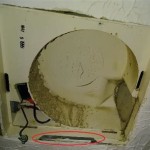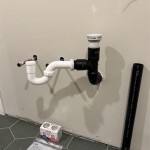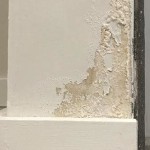Installing Bathroom Fan Ducting
A bathroom fan is an essential component of any well-ventilated bathroom. It helps to remove moisture, odors, and pollutants, keeping the air fresh and preventing the growth of mold and mildew. However, a bathroom fan can only be truly effective if it is properly ducted to the outside. This article will guide you through the process of installing bathroom fan ducting, ensuring your bathroom stays clean and healthy.
Understanding Bathroom Fan Ducting
Bathroom fan ducting is the system that transports the air drawn in by the fan from the bathroom to the outside. It is usually made of rigid PVC pipe, flexible aluminum foil duct, or a combination of both. The ducting should be sized properly to accommodate the airflow from the fan, and it should be installed with a minimum number of bends to prevent airflow restriction. The ductwork should also be securely sealed to prevent air leaks and minimize noise.
Planning the Installation
Before you begin installing bathroom fan ducting, you need to plan the route for the ductwork. Consider these factors:
- The shortest possible route: This minimizes airflow resistance and ensures optimal fan efficiency.
- Accessibility for maintenance: The ducting should be accessible for cleaning and repairs.
- Location of the vent: The vent should be positioned on an exterior wall or roof, ideally as far away from windows and doors as possible.
- Building code compliance: Check local building codes for specific requirements regarding ductwork materials, sizes, and installation methods.
Installing Bathroom Fan Ducting
Once you have planned the route for the ductwork, you can begin installing the fan. The installation process typically involves the following steps:
- Install the fan: The fan is typically installed in the ceiling or wall of the bathroom. This step usually involves hanging the fan from the ceiling joists or framing using a mounting bracket. Be sure to choose a fan that is compatible with the type of ducting material you will be using.
- Attach the ductwork: Connect the fan to the ducting using a duct connector. Ensure a snug fit to prevent leaks and maximize airflow. For rigid PVC, you will need to use glue and clamps. For flexible ductwork, you will need to use duct tape or clamps.
- Run the ductwork through the attic or walls: The ducting will need to be routed through the attic or walls to reach the vent. If using rigid PVC, cut pieces to fit the desired length and use connectors to join the pieces. If using flexible ductwork, ensure the ductwork is secured with duct tape or clips at regular intervals.
- Install the vent: The vent is typically installed on an exterior wall or roof. Choose a vent that is properly sized for the fan and ductwork. The vent will need to be sealed tightly to the wall or roof to prevent drafts and leaks.
- Seal all connections: To prevent leaks, use sealant tape or flashing around all connections, including where the ductwork meets the fan, the wall, and the vent.
Choosing Ducting Materials
The type of ducting material you choose will depend on the specific application. You will need to decide between rigid PVC pipe, flexible aluminum foil duct, or a combination of both.
- Rigid PVC Pipe: Rigid PVC pipe is a durable and cost-effective option. It is relatively easy to install and offers a tight seal, minimizing air leaks and noise. However, it is less flexible than flexible ductwork, making it more challenging to navigate tight spaces or complex routes.
- Flexible Aluminum Foil Duct: Flexible aluminum foil duct is more readily adaptable to tight spaces and complex routes. It is often easier to install compared to rigid PVC, especially in difficult areas. However, it is less durable than rigid PVC and could be prone to stretching or collapsing, which may lead to airflow restrictions.
When choosing ducting materials, it is important to consider the following:
- Distance to the exterior vent: For longer distances to the vent, rigid PVC pipe is generally preferred for its durability and less susceptibility to airflow limitations.
- Space limitations: If your bathroom has limited space, flexible aluminum foil duct might be the easier option.
- Noise reduction: For reducing noise, rigid PVC pipe generally offers better sound insulation than flexible ductwork.
Maintenance and Troubleshooting
Regular maintenance is essential for keeping your bathroom fan ducting operating efficiently and preventing issues. Here are some tips:
- Check the vent regularly: Ensure the vent is not blocked by leaves, debris, or animal nests. Clean the vent as needed.
- Clean the fan: The fan blades and motor should be cleaned regularly to prevent dust and debris buildup, which can affect fan performance.
- Inspect the ductwork: Check for leaks, bends, or blockages in the ductwork. Repair any damage or obstructions as needed.
If your bathroom fan is not working properly, you can check for the following:
- Blocked vent: Remove any obstructions from the vent.
- Blocked ductwork: Inspect the ductwork for any blockages.
- Damaged fan motor: Check the fan motor for damage. Replace the motor if it is not working properly.

Installing A Bathroom Fan Fine Homebuilding

Venting A Bath Fan In Cold Climate Fine Homebuilding
Installing A Bathroom Vent Duct

Blog

Bathroom Exhaust Fans Chicago Suburbs

Bathroom Vent Ducts Should Extend Out The Roof Gettum Associates Inc

Inspecting The Bathroom Exhaust Internachi

Adding A Bathroom Fan Fine Homebuilding

How Bathroom Exhaust Fans Work Hut

Pin On Our First Home
Related Posts







